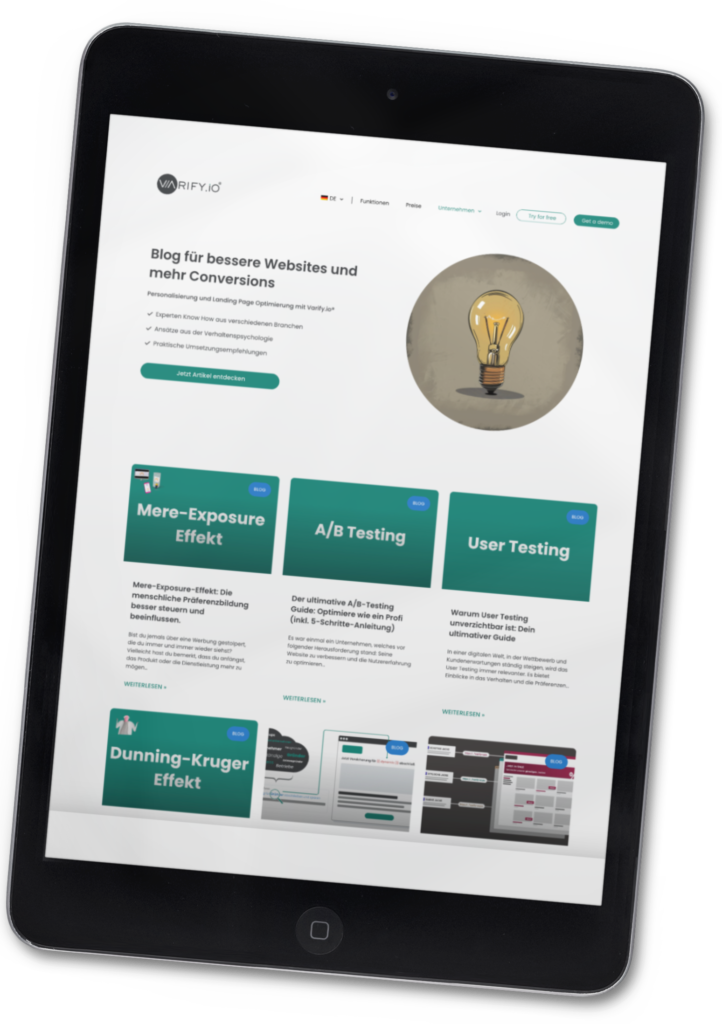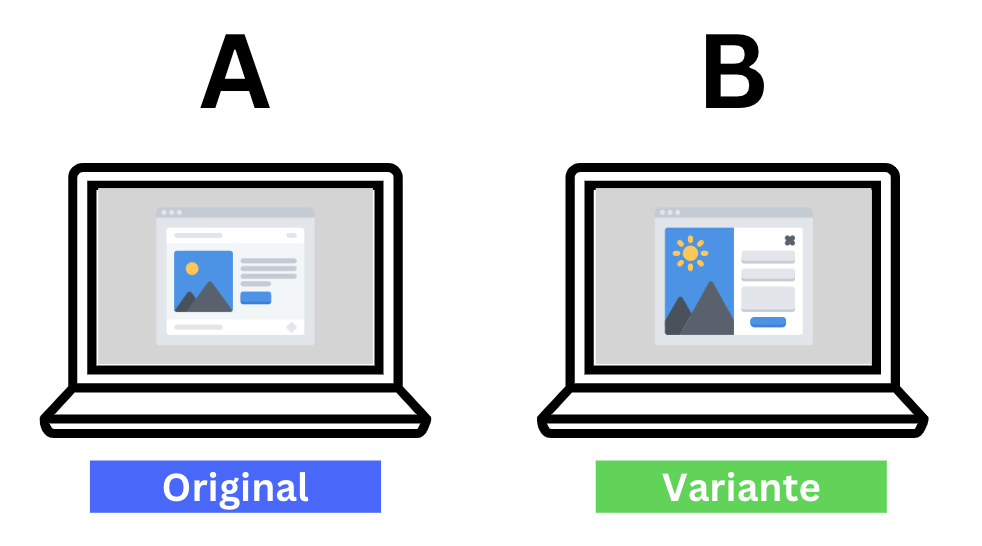
Would you like to improve the performance of your website or app?
Then you've come to the right place...
In this article, we reveal how you can use A/B testing to increase the conversion rate of your digital offers in no time at all.
The method is surprisingly simple once you get the hang of it...
And don't worry, No prior technical knowledge is required.
Simply follow this guide and the step-by-step instructions.
You will quickly see how you can optimize the interaction of your users and directly influence the success of your site or app.
Does that sound like a plan?
Then let's get started without further ado 🙂

Table of contents
Table of contents
What is A/B Testing?
A/B testing, sometimes also called split testing, is the direct comparison of two versions of your website or app - a real duel between the original and a new variant.
The behavior of your visitors is not left to chance. Rather, the power of statistics decides which version achieves your goals, such as increasing the conversion rate, more effectively.
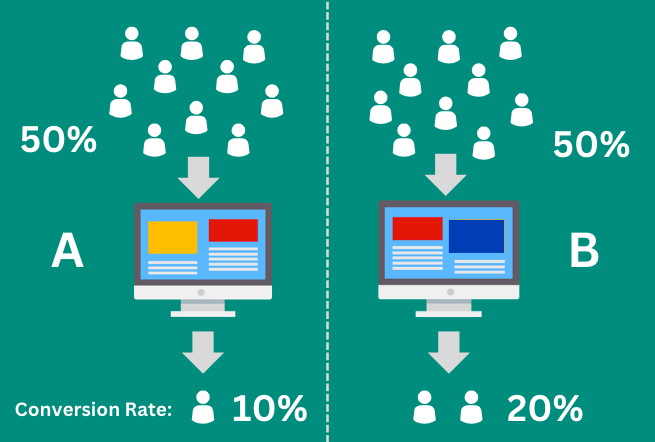
Imagine if you could test every change to your site with a safety net...
This is A/B testing: a systematic method that allows you not only to boldly tackle change, but also to accurately measure its impact.
This is how "What-if" questions into "so-it-is" answers.
Because when optimizing your online presence, it is crucial not to rely on assumptions, but on verifiable data to set. By measuring the impact of each change, you can be sure that every innovation is a step in the right direction.
Why should all companies carry out A/B tests?
While many companies invest huge budgets in various marketing channels, they often overlook a strategy that is not only cost-effective but also extremely effective: A/B testing.
This method can be considered a real goldmine, especially when it comes to increasing the conversion rate.
Whether it's selling products, generating leads or driving engagement for media content, A/B testing opens the door to achieving maximum results with minimal financial investment.
Advantages of A/B testing at a glance
Higher conversions: A/B testing is like the key to a treasure trove of conversions. By testing different versions of a website or elements, you can constantly improve the user experience and thus increase the conversion rate.
Optimized productivity and budgets: A/B tests show where resources are best deployed. This allows you to use your effort and budget more efficiently in order to achieve the optimum for each target group.
Decisions based on quantified results: A/B tests can be used to test hypotheses and minimize risks. Decisions are made on the basis of hard data, not just gut feeling.
Improved visitor insights: A/B testing is like a window into the world of visitors. You learn how different elements of the page influence behavior and can thus better respond to the needs and expectations of the target group.
Better involvement of visitors: It's about offering visitors something unique. A/B testing helps to create a website that not only appeals to visitors, but also retains them in the long term.
Successful companies - and not just giants like Amazon, Booking or YouTube - use A/B testing for a gradual, iterative improvement of their websites.
They align every step closely with the visitor and customer in order to optimize the website experience, improve the service and adapt perfectly to the target group.
A/B testing is not just a tool, it is a strategy for staying ahead in a dynamic digital market environment.
Example of a real A/B test: Carglass® study
Let's take a look behind the scenes of a real A/B test - the example of Carglass®.
Known from TV with the slogan "Carglass® repairs, Carglass® replaces", Carglass® is often the first port of call for car glass damage.
But did you know that they also offer windshield sealants?
The challenge in the initial situation was:
How can Carglass® encourage customers to book the useful additional service "Protect" (windshield sealing) more often?
The solution:
A/B testing with a good pinch of creativity! By using a clever overlay in the booking process that shows customers the benefits of windshield sealing shortly before completion, we were able to find a real recipe for success for Carglass®.
Original A
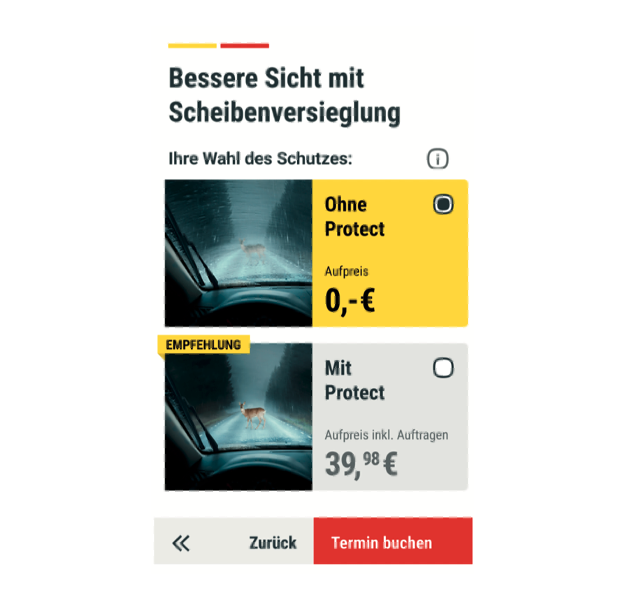
Variant B
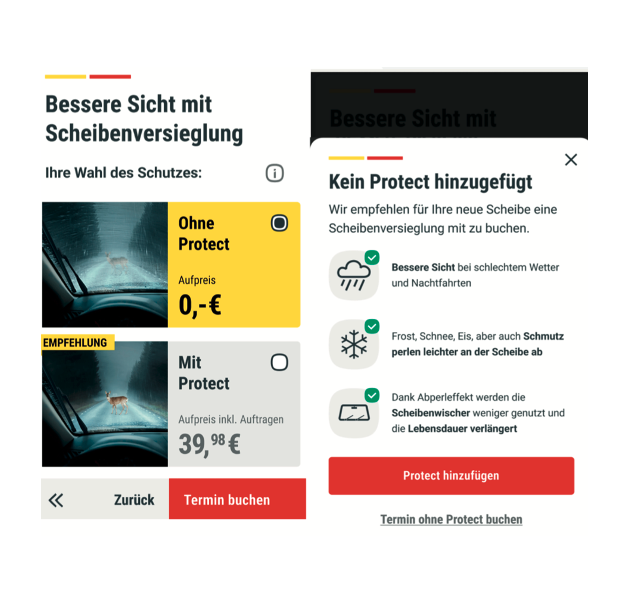
Original A

Variant B

The result: an uplift of 28.5% for variant B
An impressive increase of 28.5% in the booking rate!
And that was just the beginning. After three such tests, a cumulative uplift of 81,9% be determined - a real game changer.
These results are not just figures on paper, but have real, measurable effects - an increase in the booking rate of 182% year-on-year. You can read the entire Carglass® study here.
Remember: With the right mix of psychological triggers and clever marketing, even small changes can have a big impact.
Carglass® hit the bull's eye and the example proves that A/B testing is a powerful tool in the world of online marketing.
Now it's time for you to familiarize yourself with this powerful tool and conduct your first A/B test. Follow our 5-step guide to master the process from start to finish...
The practical 5-step guide to carrying out an A/B test
1. lay the foundation
Before you can start an A/B test, it is crucial to create a solid foundation for it...
This includes selecting suitable tools and building a strong database to gain a deep understanding of your target group and identify potential for improvement.
For data collection, analysis and tracking are Google Analytics 4 and the Google Tag Manager excellently suited.
In addition, a specialized A/B testing tool is required:
We recommend the following Varify.io®. Our in-house A/B testing tool is user-friendly, has very fair pricing with a traffic flat rate and ensures seamless integration with Google Analytics 4 or similar analytics tools.
With this combination of tools, you are ready to go and optimally equipped to carry out A/B tests successfully.


2. formulate a hypothesis
Now that the foundation has been laid with the right tools, it is time to formulate a well-founded hypothesis. This is the key to effectively launching our A/B test.
This step is based on the previously collected data and your understanding of the target group.
Think about which change could have a positive influence on user behavior or the conversion rate.
Is it a different CTA placement, a new text or perhaps a color change?
Your hypothesis should be specific, measurable and based on previous analysis to maximize the success of your A/B test. To make the concept of a hypothesis more tangible, let's look at a concrete example below.
Example of a formulated hypothesis:
If the visitor is only shown a clear before/after effect in the form of 2 images,
then the acceptance rate for windshield rain repel increases,
because the decision as to whether to add a windshield sealant is made spontaneously and emotionally.
Implement 3rd variant technically
Once you have established a well-founded hypothesis, it is time to implement it technically as a test variant.
Depending on your resources and technical skills, you can take on this task yourself or enlist the support of your IT team. The goal is to ensure a smooth implementation that allows you to A/B test the original version of your site against the new variant.
You then need to set up the A/B test in your A/B testing tool.


4. start test and wait
Now that everything is technically prepared, you are entering the hot phase: the start of your A/B test.
This moment is the beginning of an exciting journey to optimize your website. The important thing now is to be patient!
Your A/B test needs sufficient time to generate significant data. The time period can vary between a few days and weeks. Depending on the traffic on your website and the performance of the original (A) and the variant (B).
It may be tempting to want to interpret results early, but the real strength lies in waiting. This is the only way to ensure that your results are statistically significant and your insights are reliable.


5. evaluate test
Once the A/B test has been completed, it's time to get serious about the evaluation and bear the fruits of our labor.
Here it is important to carefully analyze the collected data to find out which version - the original (A) or the test version (B) - performed better.
There are two ways to do statistical analysis: either you dive deep into the subject of statistics, or you use our Significance calculatorwhich simplifies the process considerably.
Simply enter the number of visits and conversions for both versions in our calculator and select the desired confidence level.
The confidence level defines the probability with which the results are considered statistically significant. A default value of 95% means that you can be 95% sure that the differences are not random.
Use this tool to quickly and easily determine whether your hypothesis is confirmed and which changes you should implement permanently. Click here to go directly to the significance calculator.
Attention: It's not just the "winner" that counts. Every test result, whether positive or negative, provides valuable insights. Use this data to understand what your users really want and how you can improve their experience.
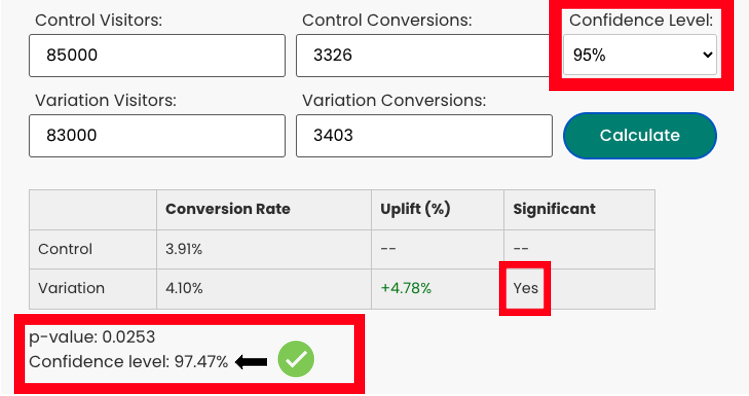

Win or lose: what comes after the test
Has your new variant won the race? Then it's time to firmly integrate these changes into your site and enjoy the success.
If not, don't worry: every test is a step forward. Use the insights, refine your ideas and start the next attempt. Remember, every round offers new opportunities to further perfect your site.
Let's move on to the next experiment!
A/B testing is not a one-off project, but an ongoing process. Use the findings from each test to formulate new questions and plan your next test.
This will help you improve the performance of your website step by step and ensure an optimal user experience. Stay curious and keen to experiment!
What types of A/B tests are there?
In the world of A/B testing, there is more than one way to put your ideas to the test. Each method has its own charm and purpose, depending on what you want to scrutinize.
Classic A/B test - client side testing
Let's start with the most common test - the classic A/B test. Here you play detective with two suspects: Version A, your current page, and Version B, which involves a major change to the website. These changes are made either with a visual editor or with JavaScript or CSS. The change made optimizes the original version of the website while it loads. However, this happens so quickly that the visitor does not notice anything.
Both versions share a URL, which makes things uncomplicated. This method is ideal for increasing the conversion rate as quickly as possible.
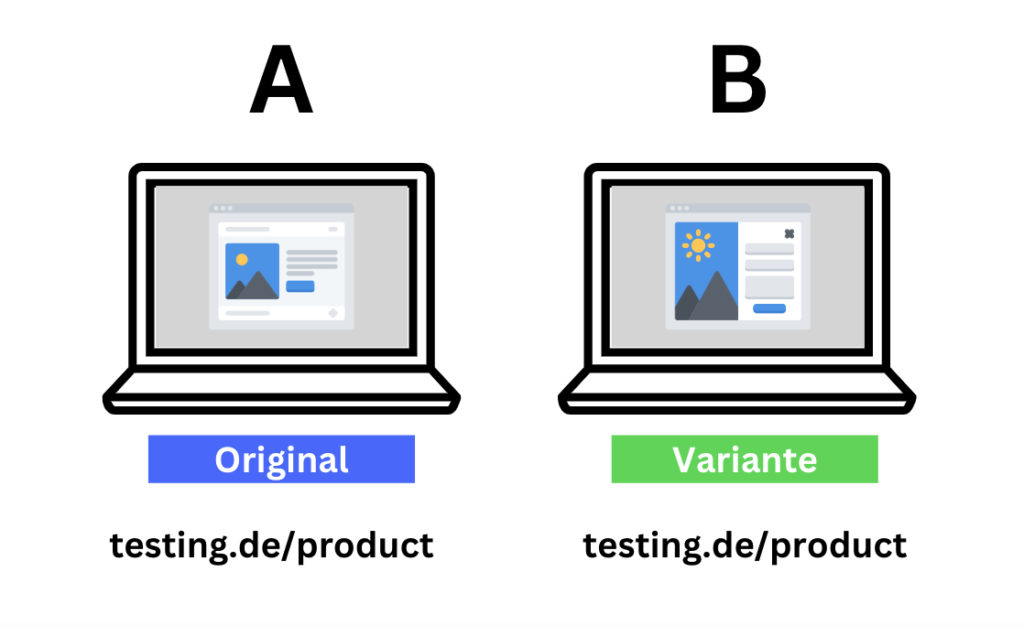

The classic A/B test is your direct route to clear decision-making. It allows you to quickly see which small changes have the greatest effect and thus forms the The backbone of your optimization strategy.
Split URL test
Sometimes a small change is not enough and you have to bring out the big guns.
This is where the split URL test comes into play. Imagine you have two completely different designs for your website - how do you decide which one is better?
Exactly, by splitting the traffic between two different URLs, each hosting one of the versions. Suitable for the brave souls who are willing to test radical changes.
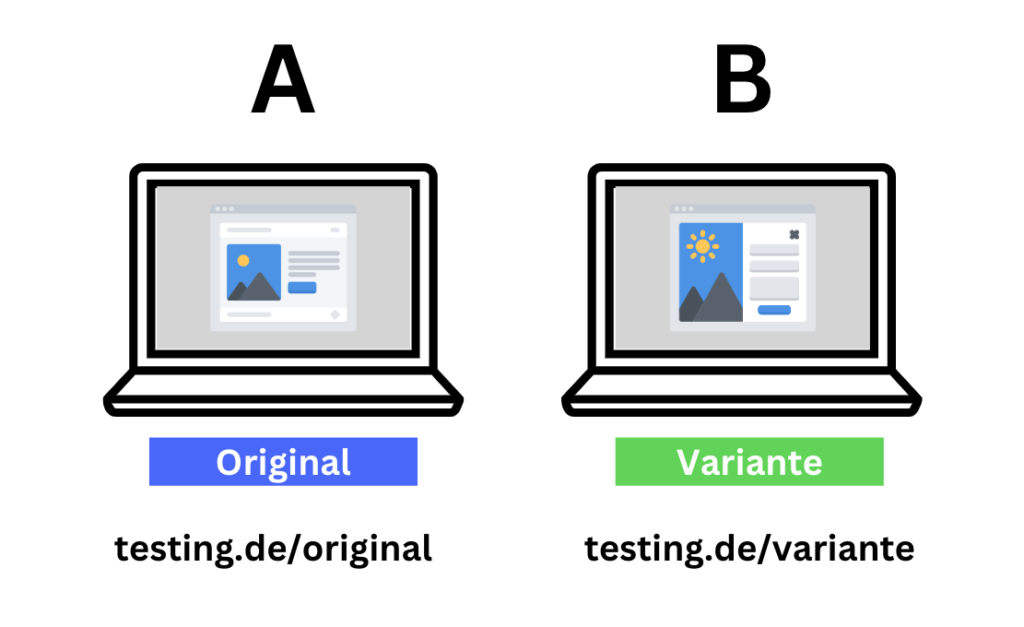

Multivariate tests
Multivariate tests go one step further than classic A/B and split URL tests. Instead of focusing on a single variable, they allow you to test multiple elements and their combinations simultaneously.
This way you can find out which elements together have the strongest effect on the user experience and conversion rates.
Perfect for those who want to fully exploit the complexity of their websites, the multivariate test offers deep insights into the interaction of different design and content aspects. But be careful - you need a lot of traffic on your site to get statistically significant results.
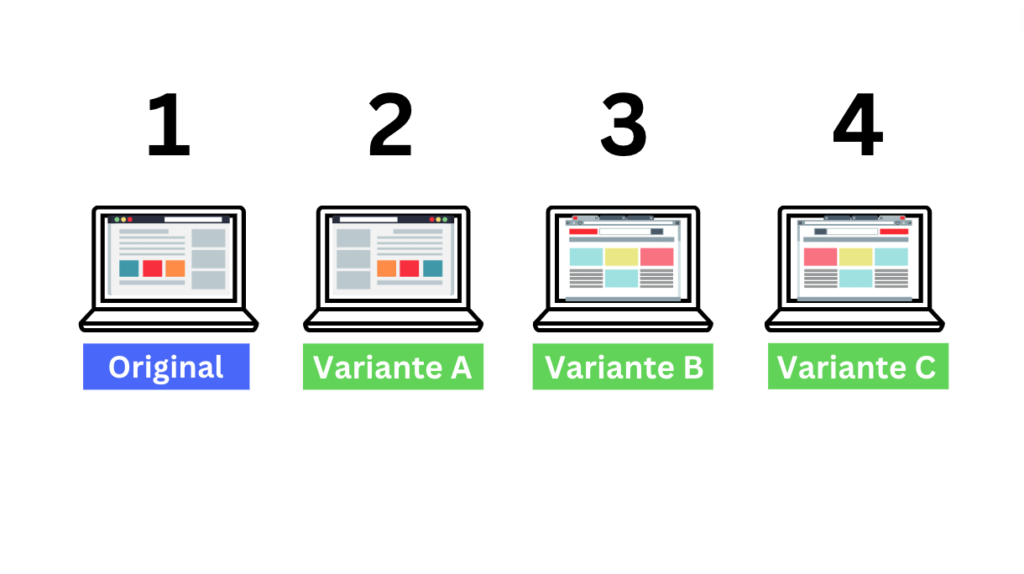

This method allows you to maximize your site's optimization potential by understanding how different changes work together to influence user behavior.
How do you find ideas for an A/B test?
To find ideas for your first A/B test, it's helpful to start with a clear view of your goals and user needs.
Ask yourself: What do I want to improve? How can the user experience be optimized?
As a source of inspiration and to help you get started, consider the following 20 elements that are ideal for initial testing and have the potential to significantly improve the user experience and conversion rate of your website.
You could use these elements for an A/B test
1. headings: Test different wording to increase engagement. Try using emotive or action-oriented language to see which best captures the attention of your target audience.
2. call-to-action (CTA) buttons: Color, size, and positioning can influence click-through rates. Experiment with direct calls to action versus more subtle messages to measure effectiveness.
3. pictures: Different images can vary user engagement. For example, test emotional versus factual images to observe the impact on user behavior.
4. Product descriptions: Detail and style can influence the buying decision. Try technical versus colloquial descriptions to identify your customers' preferences.
5. layouts: The arrangement of elements on the page can improve the user experience. Change the position of key elements such as testimonials or product benefits to test their influence on the conversion rate.
6. menu structures: Clearly structured navigation helps users to find their way around your site. Test different menu layouts to maximize user-friendliness.
7. form elements: The design of forms can have a strong influence on the conversion rate. Try out different layouts and numbers of fields to encourage users to complete the form.
8. color schemes: Colors play an important role in the psychological impact of a page. Experiment with different palettes to control emotional reactions and actions.
9. checkout process: The design of your checkout process can be decisive for the completion of a transaction. Test different layouts, field counts and wording in the calls to action. A clear, simple checkout can significantly reduce the abandonment rate and improve the conversion rate.
10. pricing: The way prices are presented can strongly influence users' decisions. Investigate whether crossed-out prices, bundled offers or highlighting the value improve conversion.
11. testimonials and reviews: Incorporating customer feedback can create trust and increase credibility. Test different placements and formats to measure their impact.
12. social proof: Show how popular your offer is. Test different representations of user numbers or social proof.
13. offers and discounts: Different ways of presenting offers can motivate users to buy. Experiment with different formulations and placements.
14. content formats: Switching between text, images and videos can influence engagement. Find out which format your target group prefers.
15. landing pages: The presentation of your offers can influence the conversion rate. Test different landing pages to determine the most effective one.
16. FAQ section: A clearly structured FAQ section can help to reduce uncertainty among users. Test the placement and design of this area.
17. search functionalities: An intuitive search function makes it easier to find information. Experiment with the design and placement of the search bar.
18. registration processes: Simplify the registration or purchase process to increase user loyalty. Test different forms and steps.
19. fonts: The readability and general appearance of your content can be influenced by the font. Test how different fonts affect the perception of your brand and readability.
20 Mobile responsiveness: Optimal display on mobile devices is crucial. Test different designs for an improved user experience on smartphones and tablets.
With this selection of test elements, you are well prepared to enter the world of A/B testing.
In addition, a deeper understanding of conversion optimization will enable you to test even more effectively and improve your website in a targeted manner.
In the next section, we will therefore focus specifically on psychological triggers, a key aspect of conversion optimization.
Psychological triggers: The secret weapon in conversion optimization
To get off to a successful start with A/B testing, a solid understanding of conversion optimization is essential...
An essential part of this are psychological triggers that intervene deeply in your users' decision-making. These triggers use basic human tendencies to positively influence the behavior and decisions of your website visitors.
By using these triggers in your A/B tests, you can not only improve the user experience on your site, but also significantly increase your conversion rate.
So let's take a look at some psychological triggers:
Decoy effect
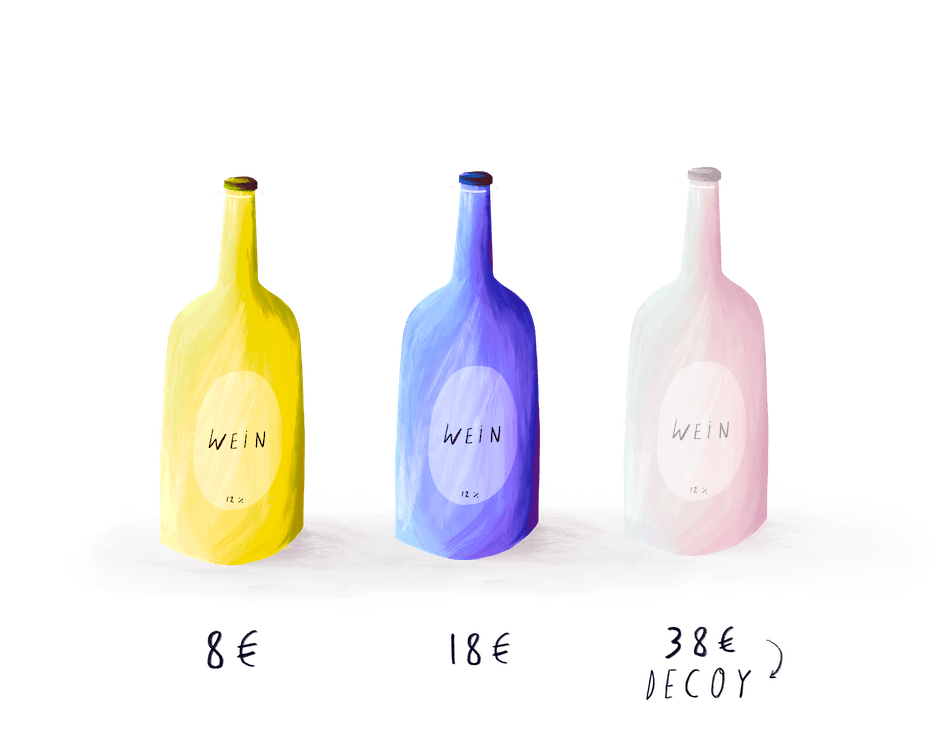
Decoy effect
Affect heuristics

Affect heuristics
Feel instead of think - emotions often guide us faster than the mind. Use this knowledge to encourage your visitors to make quick decisions with emotionally appealing elements. Find out more about the affect heuristic here.
Primacy effect

Primacy effect
As with the first chapter of a book, the first impression on your website will shape what users expect and how they react. Use this knowledge to build a strong, positive connection right from the start. Show your best offers and content first to create a lasting impact. Find out more about the primacy effect here.
Mere exposure effect
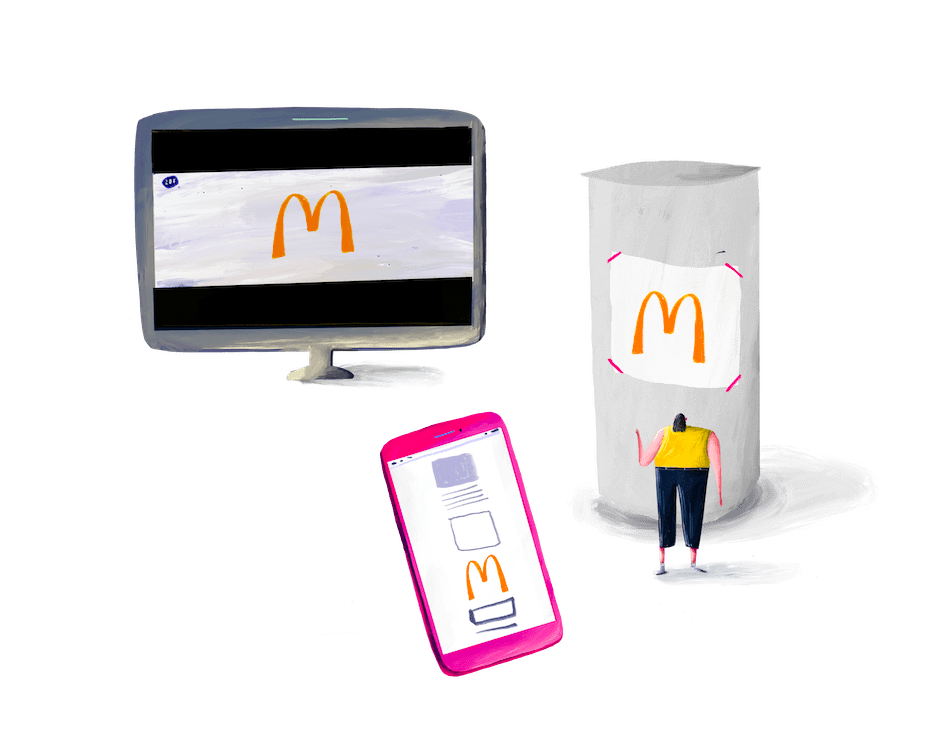
Mere exposure effect
Paradox of Choice

Paradox of Choice
Too many options can quickly become overwhelming. By specifically reducing the number of choices, you simplify the decision-making process for your users and increase the chance of a conversion. A clear, focused path leads to more satisfied visitors. Find out more about the Paradox of Choice here.
Framing effect
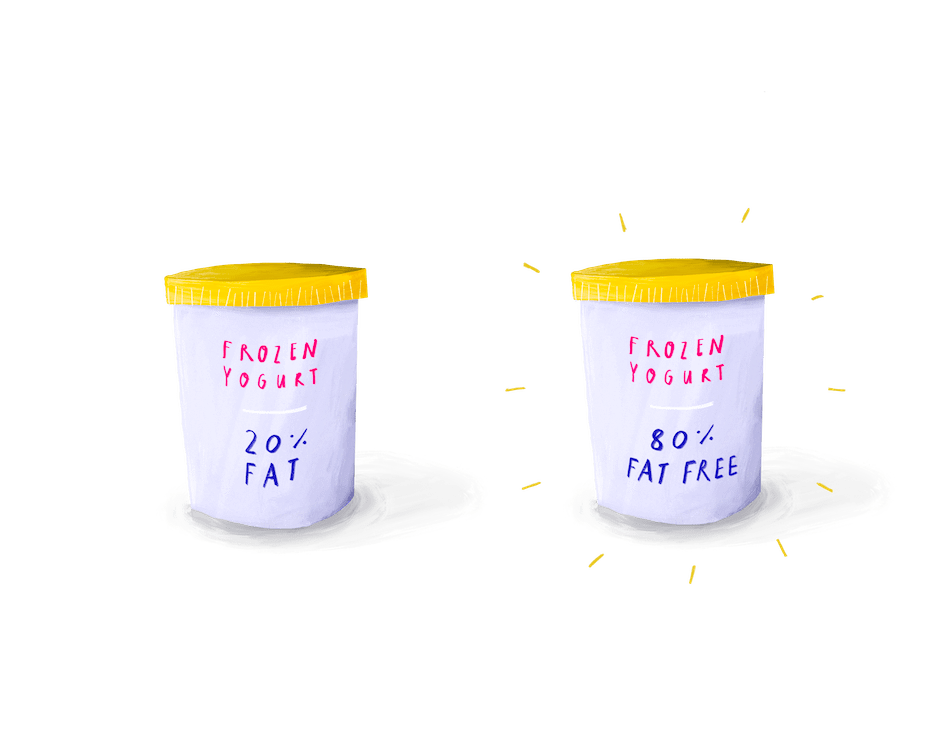
Framing effect
The way you present information shapes perception. A positive frame around your offers can significantly increase their attractiveness and encourage users to make a decision in your favor. Find out more about the framing effect here.
Scarcity

Scarcity
The feeling that something could soon no longer be available awakens desire. Use scarcity to emphasize the value of your offers and motivate users to act quickly. Find out more about Scarcity here.
What mistakes should be avoided in A/B testing?
Especially at the beginning, many people stumble over frequent errors that not only consume resources but can also distort the results.
In this section, we'll show you how to avoid typical A/B testing mistakes so that your optimization strategies stay on track and your conversion rate doesn't suffer unnecessarily.
With the right know-how and precise execution, you can take full advantage of A/B testing without falling into the common traps.
1. rely on intuition instead of data
In online marketing, every click counts, and this is exactly where A/B testing comes into its own. Perhaps you have a strong gut feeling as to which headline is better received or which design drives up the conversion rate.
But wait! Before you listen to your gut feeling, let the data speak for itself. Collecting and analyzing user interactions will give you indisputable proof of which variant actually delivers the better results.
Remember: data doesn't lie, but our intuition can sometimes lead us astray.
2. underestimate sample size
2. underestimate sample size
Sample size may sound like dry statistics, but it's your best friend when it comes to meaningful A/B tests. Too small a sample size can lead to you making changes that don't actually make any real difference.
It's like fishing with a net that's too small: you could miss the big fish. Make sure your sample is large enough to provide truly representative and reliable results. Remember, in the sea of data, the size of the net matters.
3. adjust settings or variables during the test
Imagine you're on a treasure hunt, but the map is constantly changing. This is what it feels like when you change the rules of the game during an A/B test.
Consistency is the be-all and end-all for valid test results. If you change the conditions while the test is running, you will lose track of which changes lead to which results. So stick with it, even if it's tempting to make adjustments along the way. You will only find the real treasures - in other words, the valuable insights - if you follow the original map.
4. distribute traffic unevenly
A fair distribution of traffic across your test variants is like watering your plants: too much water here, too little there, and growth suffers.
If one variant receives more visitors than the other, this can distort the test results. It's like giving one side a head start in a race. Make sure that each variant starts under the same conditions so that you can see at the end which one really has the edge.
5. misinterpret test results
After you have carefully planned and carried out your A/B test, it's time for the evaluation - and this is where another trap lurks. The correct interpretation of your results is crucial.
Statistical significance is not just a buzzword, but your benchmark for assessing whether the differences between the variants are really significant. It's not just about who wins the race, but also by what margin. Only then can you be sure that the changes you make are on solid ground.
6. neglecting teamwork
One of the most critical mistakes in A/B testing is to work in silence and not involve the team.
A test is so much more than just an experiment; it's an opportunity to learn and grow together. By getting your team on board, you benefit from different perspectives and expertise that can significantly increase the quality and relevance of your tests.
Remember that A/B testing is not a solo adventure, but a team effort that thrives on diversity of thought and experience.
7. testing too many variables at the same time
Testing too many variables at once can quickly lead to disaster. It's like juggling: The more balls you have in the air, the harder it is to catch them all. Limit yourself to one or two changes per test to clearly identify what exactly makes the difference. This will avoid confusion and ensure you get clear, actionable insights from each test.
8. skip iterative processes
A/B testing is a marathon, not a sprint. The key to success lies in repetition and continuous improvement. Each test offers the opportunity to learn and apply what you have learned in the next test.
If you skip this iterative process, you deprive yourself of the chance to find truly optimal solutions. Always remember: The first test is only the beginning, not the end of the optimization journey.
9. disregard external factors
The world of the Internet is dynamic and influenced by many external factors. Whether seasonal fluctuations, public holidays or current events - all these factors can influence the results of your tests.
By ignoring external factors, you risk misinterpreting the test results. Be sure to consider the context of your tests and plan them accordingly.
10. persist with simple A/B tests
Last but not least, limiting yourself to simple A/B testing can prevent you from realizing the full potential of your optimization efforts.
While simple tests are great for learning the basics and getting quick wins, it's also important to explore more advanced testing methods. These allow you to gain deeper insights into user behavior and answer more complex questions.
Questions and answers
Here you will find answers to the most burning questions that will help you to successfully master the art of A/B testing:
How do you integrate A/B testing in your company?
To anchor A/B testing in your company, for example, start with a workshop that demonstrates the value: How can small changes have a big impact?
Build a cross-functional team that is on board from the start to plan and execute the tests. Set common goals and provide a platform that allows everyone to see results in real time.
This is how you create a culture in which data-driven decisions become the norm.
To overcome possible resistance, it is also essential to communicate the potential and significance of this method clearly and convincingly to decision-makers.
Show how A/B testing provides direct insights into user behavior and puts decisions on a solid data basis, leading to more conversions, sales and ultimately better products and services.
We recommend:
- Note possible resistances: Deal with possible skepticism in the team and among decision-makers as well as frequent fear of change.
- Carry out persuasive work: Demonstrate the ROI and the improvement in user experience.
- Get professional support: Consider bringing in experts to facilitate the integration process with specialist knowledge and best practices.
By combining clear arguments, practical examples and the willingness to invest in professional support, A/B testing can be successfully established as a valuable tool in the company.
What are the limits of A/B testing?
A/B testing cracks the surface of what works on your website, but it reaches its limits when it comes to uncovering the deeper whys.
That's why it's important to think outside the box...
Immerse yourself in the world of Conversion optimization and behavioral economics. These fields provide you with the tools to not only recognize which changes bring success, but also to understand why this is the case.
It's about developing a deeper understanding of your users' needs and motivations and making your website a place that not only works, but also fascinates and engages.
What are the challenges of A/B testing?
One of the biggest challenges with A/B testing is actually patience. Waiting for significant data can be a real test of patience, because jumping to conclusions could misdirect your optimization strategy.
It is equally important to maintain a balance between the quantity and quality of tests. Too many tests at once could leave you drowning in a flood of data. While too few tests won't reveal the full potential that A/B testing offers for optimizing and understanding user preferences.
The secret lies in making a strategic choice:
By prioritizing tests with the greatest potential for meaningful insights, you maximize the value of each test and avoid data overload.
How do I carry out A/B tests in line with SEO?
To carry out A/B tests effectively and in line with SEO practices, the following approach is essential.
First the good news: search engines like Google support and encourage A/B testing. As long as they are implemented correctly, search engine rankings will not be negatively affected.
Here are three basic guidelines that will help:
1. strictly avoid cloaking: Cloaking, i.e. showing different content to visitors and search engines, can damage your website. It's important that all users, including Googlebot, see the same content. This approach ensures that your A/B tests remain transparent and in line with Google's guidelines, which protects the integrity of your SEO efforts.
2. use of 302 detour: For A/B tests that require a redirect from the original URL to a test URL, the use of 302 redirects is preferable to 301 redirects. 302 signals that the redirect is only temporary, ensuring that the original URL remains in the search engine index.
3. use of the rel="canonical" attribute: To avoid confusion for search engines and to signal which page should be considered the main content, the rel="canonical" attribute should be used on all test URLs that refer to the original page. However, this only applies to split URL tests.
By observing these Guidelines you can ensure that your A/B testing complements, rather than undermines, your SEO efforts. It's key to take full advantage of A/B testing without jeopardizing your search engine rankings.
What should you look out for in an A/B testing platform?
When choosing an A/B testing platform, you should pay attention to user-friendliness, integration with other tools and the type of data analysis.
A good platform will allow you to easily create, manage and analyze tests without having to become a data scientist. Also make sure that it integrates seamlessly with your existing tech stack.
High-quality platforms can be expensive, so it is important to find good value for money.
Our platform Varify.io® offers a comprehensive solution that not only fulfills the above criteria perfectly, but is also efficient in terms of costs. Even with increasing traffic, the prices do not increase due to our traffic flat rate.
How can A/B testing be used by different teams?
A/B testing is not just for online marketers...
Product teams can use it to refine features, development teams to improve usability, and content teams to measure the impact of their copy.
The key is for each team to formulate its own hypotheses and carry out tests that are aligned with its objectives. This makes A/B testing a versatile tool that creates value across departmental boundaries.
